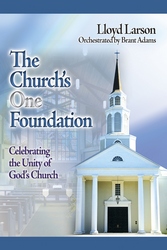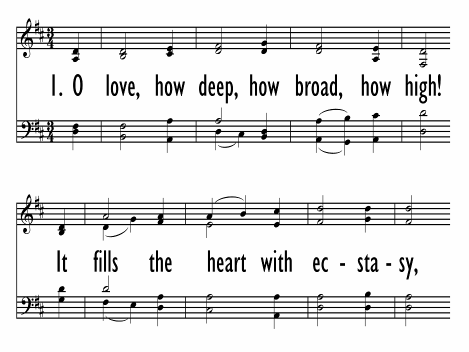- |
User Links
EISENACH (Gesius)

EISENACH (Gesius)
Composer: Bartholomäus Gesius; Adapter: Johann Hermann Schein (1628)Published in 286 hymnals
Printable scores: PDF, MusicXML
Audio files: MIDI, Recording
Composer: Bartholomäus Gesius
Bartholomaeus Gesius; b. 1555, Muencheberg, near Frankfort; d. 1613 or 14, Wittenberg Evangelical Lutheran Hymnal, 1908 Go to person page >Adapter: Johann Hermann Schein
 Schein, Johann Hermann, son of Hieronymus Schein, pastor at Griinhain, near Annaberg, in Saxony, was born at Grünhain, Jan. 20,1586. He matriculated at the University of Leipzig in 1607, and studied there for four years. Thereafter he acted for some time as a private tutor, including two years with a family at Weissenfels. On May 21, 1615, he was appointed Capellmeister, at the court of Duke Johann Ernst, of Sachse-Weimar; and in 1616 he became cantor of I3t. Thomas's Church, and music director at Leipzig, in succession to Seth Calvisius (d. Nov. 24, 1615). This post he held till his death, at Leipzig, Nov. 19, 1630.
Schein was one of the most distinguished musicians of his time, both as an original composer, and as a harmoniser of the… Go to person page >
Schein, Johann Hermann, son of Hieronymus Schein, pastor at Griinhain, near Annaberg, in Saxony, was born at Grünhain, Jan. 20,1586. He matriculated at the University of Leipzig in 1607, and studied there for four years. Thereafter he acted for some time as a private tutor, including two years with a family at Weissenfels. On May 21, 1615, he was appointed Capellmeister, at the court of Duke Johann Ernst, of Sachse-Weimar; and in 1616 he became cantor of I3t. Thomas's Church, and music director at Leipzig, in succession to Seth Calvisius (d. Nov. 24, 1615). This post he held till his death, at Leipzig, Nov. 19, 1630.
Schein was one of the most distinguished musicians of his time, both as an original composer, and as a harmoniser of the… Go to person page >Tune Information
| Title: | EISENACH (Gesius) |
| Adapter: | Johann Hermann Schein (1628) |
| Composer: | Bartholomäus Gesius |
| Meter: | 8.7.8.7.8.8 |
| Incipit: | 13455 43256 71766 |
| Key: | D Major |
| Source: | Gotha Cational, 1715 |
| Copyright: | Public Domain |
Alternative Tunes
Notes
MACHS MIT MIR was first published in the collection of music Das ander Theil des andern newen Operis Geistlicher Deutscher Lieder (1605) by Bartholomäus Gesius (b. Münchenberg, near Frankfurt, Germany, c. 1555; d. Frankfurt, 1613). A prolific composer, Gesius wrote almost exclusively for the church. Gesius studied theology at the University of Frankfurt and pursued his musical studies privately. He was a cantor in Münchenberg, a private tutor for a poet's family in Muskau, and a cantor at the Marienkirche in Frankfurt from 1593 until his death. He composed numerous settings for pre-Reformation Latin songs and for Reformation hymns (with Luther's hymns well represented) and published them in ten volumes, including his Psalmodia Choralis and Geistliche deutsche Lieder (1601). He also wrote a St. John Passion (1588), a St. Matthew Passion (1613), important settings of the Magnificat (1607), and a theoretical work, Synopsis musicae practicae (1609).
Johann H. Schein later adapted Gesius's tune for his own hymn text "Machs mit mir, Gott" (1628)–from which the tune got its name–and published it in the second edition of his famous Cantional (1645). [Hymnary ed. note: Schein died in 1630, so someone else published the second edition] Johann S. Bach (PsH 7) used the tune in his St. John Passion (1724) and in his Cantatas 139 and 156. An isorhythmic version of the tune was published in the 1959 Psalter Hymnal under the name EISENACH. Dale Grotenhuis (PsH 4) prepared the harmonization in 1985 for the 1987 Psalter Hymnal.
Like so many chorales, MACHS MIT MIR is in bar form (AAB); its rhythms alternate between duple and triple–in this case the use of the two main forms of musical rhythm is a nice way of suggesting that God's providence covers all! Unison singing may be best on the stanzas, with harmonizing optional on the refrain. Sing this tune with much energy to an animating tempo.
--Psalter Hymnal Handbook
Timeline
Arrangements
Harmonizations, Introductions, Descants, Intonations
|
Organ Solo
|
Piano Solo
|
Instruments: Instrumental Solo with Organ
|
Voices: Organ and Voice
|
Media
The Cyber Hymnal #747
Text: Captain of Israel's HostThe Cyber Hymnal #951
Text: Come Then, Thou Prophet of the LordThe Cyber Hymnal #985
Text: Come, Follow Me, the Savior SpakeThe Cyber Hymnal #1760
Text: Great God, Who, Hid from Mortal SightThe Cyber Hymnal #3705
Text: Lord God of MorningThe Cyber Hymnal #5886
Text: Salvation Is Forever NighThe Cyber Hymnal #6679
Text: Thou Hallowed Chosen Morn of PraiseThe Cyber Hymnal #6865
Text: To Realms of GloryThe Cyber Hymnal #9890
Text: Do We Not Know That Solemn Word?The Cyber Hymnal #12066
Text: Incarnate Word, Who, Wont To DwellThe Cyber Hymnal #12130
Text: See, How Rude Winter's Icy HandThe Cyber Hymnal #15799
Text: Oh May The Gospel Swiftly SpreadPsalter Hymnal (Gray) #190
Text: God's Gift It Is to Eat and Drink- MIDI file from Christian Classics Ethereal Hymnary #658
- MIDI file from Christian Classics Ethereal Hymnary #658
- MIDI file from The Cyber Hymnal #747
- MIDI file from The Cyber Hymnal #951
- MIDI file from The Cyber Hymnal #985
- MIDI file from The Cyber Hymnal #1760
- MIDI file from The Cyber Hymnal #3705
- MIDI file from The Cyber Hymnal #5886
- MIDI file from The Cyber Hymnal #6679
- MIDI file from The Cyber Hymnal #6865
- MIDI file from The Cyber Hymnal #8978
- MIDI file from The Cyber Hymnal #9215
- MIDI file from The Cyber Hymnal #9890
- MIDI file from The Cyber Hymnal #10440
- MIDI file from The Cyber Hymnal #12066
- MIDI file from The Cyber Hymnal #12130
- MIDI file from The Cyber Hymnal #15799
- Audio recording from Evangelical Lutheran Worship #799
- MIDI file from Psalter Hymnal (Gray) #190
- MIDI file from Psalter Hymnal (Gray) #190
- Audio recording from Small Church Music #1211
- Audio recording from Small Church Music #2366
- Audio recording from Small Church Music #2504
- Audio recording from Small Church Music #4275
- Audio recording from Small Church Music #4275
- Audio recording from Small Church Music #6351
- Audio recording from Small Church Music #6898
- Audio recording from Worship (4th ed.) #447


 My Starred Hymns
My Starred Hymns





